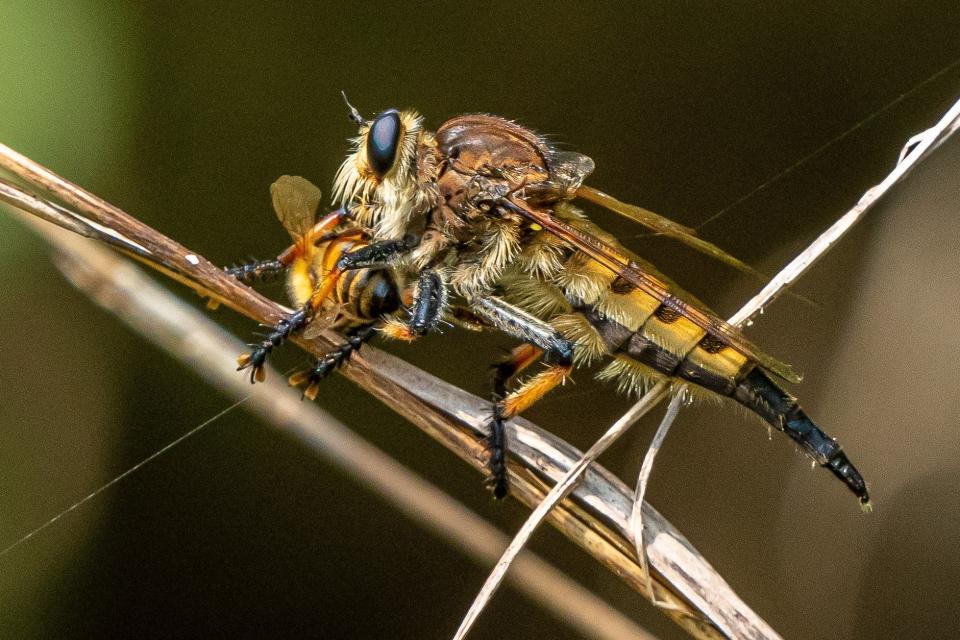Fall is the time to appreciate insects' beauty and skills | ECOVIEWS
The autumnal equinox, the day when the earth’s tilt moves the sun across the equator, falls between Sept. 21 and 24. This year the days will be shorter than the nights for six months starting Sept 23.
Springtime is generally viewed as the prime season to see wildlife, but we should not dismiss late summer and fall for outdoor adventures. Wildflowers are in bloom everywhere and with their bounty come insects looking for food.
More: Leopold benches have a connection to the environment | ECOVIEWS
Meals for flying insects in the fall come in two categories. One includes nectar and pollen sought by butterflies, wasps and bees. The other includes the winged bugs themselves, the targets of dragonflies, damselflies and robber flies.
I was fortunate to have taxonomic experts on all these creatures visit Salleyland recently. Some focused on the pollen seekers, others on their predators. Once again I was awed at the array of biodiversity found and identified by trained field entomologists armed with binoculars and cameras.
For example, members of the Carolina Butterfly Society introduced me to more different kinds of butterflies in one day than I knew were on the property — 35 species! Some species require a butterfly lover (aka lepidopterist) to confirm proper identification. Members of the group were able to ID butterflies on sight.
Fortunately for me, several folks were armed with cameras as long as my arm that could take up-close-and-personal photos. This allowed the experts to show me how to tell butterflies and dragonflies apart by looking at the key identification markers on a digital camera screen instead of chasing them across swamps and fields and into the forest.

A high biodiversity of butterflies and other insects is a rough measure of a region's environmental health because many species are particular about what plants they lay their eggs on — the plants on which the caterpillars will feed. An abundance of butterflies probably indicates a high diversity of native plants.
Swallowtails, the butterfly family with some of the largest and showiest butterflies in the world, warrant celebrity status among insects. We saw three kinds on our field trip.
The spicebush swallowtails we saw relied on the locally abundant sassafras, one of the preferred plants for the species. The abundance of Palamedes swallowtails, large black butterflies with yellow markings, were a consequence of the numerous red bay trees growing in the swamp. We also saw tiger swallowtails, which that feed on nectar from many plants.
Even I can identify monarch butterflies. Their presence indicates that a milkweed plant was available somewhere during the caterpillar stage. For these long-distance flyers, the plant might have been miles away.
Many lepidopterists are also dragonfly experts, and these four-winged, fast-moving aerial predators were out in force, patrolling fields and ponds in search of flying insects. In shady streamside areas and in the swamp, damselflies were common. Dainty ebony jewelwings flitted about, with their shiny black wings and metallic green or blue abdomen (the long body extension that looks like a tail). The gentle nature of these charming creatures should make anyone appreciate watching them at the edge of a swamp.
Autumn is the time to enjoy many kinds of insect pollinators. We saw small beetles and elegant solitary wasps on blooming wildflowers. A robber fly, a member of a family known as assassin flies, made the catch of the day. Robber flies have no interest in humans, but they are deadly to other insects. They sit in ambush mode and attack their prey in midflight, injecting a paralyzing saliva. As we watched, one grabbed a honeybee out of the air then used its long proboscis to extract its meal.
We shouldn't take butterflies, dragonflies and other beneficial insects for granted. Learn to appreciate not only the startlingly beautiful ones but also the ones with other traits, such as spectacular predatory skills.
Collectively, these aerial sentinels tell us that the natural world is working properly. Take an insect walk while the days are still warm and hope they are still abundant wherever you are.

Whit Gibbons is professor of zoology and senior biologist at the University of Georgia’s Savannah River Ecology Laboratory. If you have an environmental question or comment, email ecoviews@gmail.com.
This article originally appeared on The Tuscaloosa News: Fall is the time to appreciate insects' beauty and skills | ECOVIEWS
